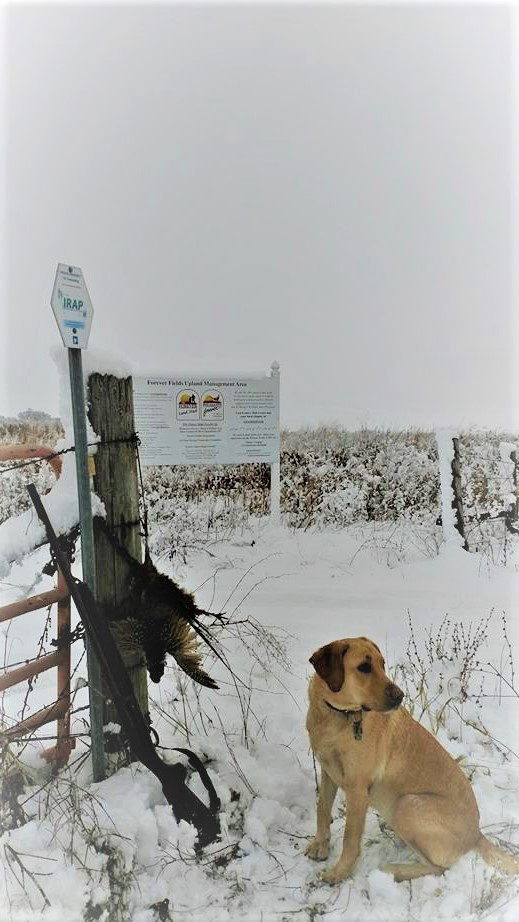
Successful hunters of a IRAP site.



Successful hunters of a IRAP site.
Photos courtesy of the author.
The 2018 Farm Bill was signed December 20, 2018 and has a substantial impact on wildlife habitat now that Conservation Programs are going full throttle across the country. The conservation section of the bill, Title II, provides nearly $30 billion through 2023 to impact millions of acres of habitat which is good news for farmers, landowners and outdoorsmen and women. Here’s a breakdown of programs available and their impacts.
This is the most recognized program that provides habitat to wildlife in Illinois. The new bill increased the national CRP acreage cap to 27 million acres which means there is opportunity for Illinois landowners to apply for CRP practices. This past summer, USDA held a sign up for Continuous CRP practices, such as wetlands and filter strips, that affect water quality and provide varying benefits to wildlife. Additionally, USDA is planning a General CRP sign up starting December; the exact details are not known as this article is published, but information will be published as soon as possible and landowners can check-in with their USDA Service Center. USDA reports show that between this fall and October 2020, more than 7 million CRP acres will be open for enrollment. Illinois landowners should apply for as many of those acres as possible so that the program continues to provide benefits for wildlife, along with reducing soil erosion and improving water quality.

VPA-HIP funds the Illinois Recreational Access Program (IRAP), where private land is voluntarily enrolled into the public use program for hunting, fishing and access. Nationally, $50 million was re-authorized for VPA-HIP meaning Illinois conservationists can have expanded opportunity for hunting, fishing and access. Currently 22,134 acres are enrolled in IRAP and the number is growing. Sites in the program receive active management from the Illinois Department of Natural Resources (IDNR), Pheasants Forever-Quail Forever, and other partners, so consider applying to hunt at an IRAP site.
This working-lands based program offers incentives for producers to do environmentally friendly practices and now has an increased focus on funding for wildlife practices. Illinois’ EQIP wildlife practices focus on bobwhite quail habitat and monarch butterfly habitat which provide habitat for hundreds of other organisms. Producers can apply for EQIP at any time.
This program offers landowner easements where wetlands are protected and restored and where farmers can keep their land in agriculture when under pressure to develop. ACEP funds have been elevated to $2.25 billion nationally over the next five years. The highest density of ACEP wetland easements lies along Illinois’ major rivers. With record flooding in 2019, ACEP wetland easements should be a consideration for many landowners. Additionally, the historic dollar figure for ACEP funding should bode well for waterfowl and other wildlife.
The CSP program helps producers maintain and improve existing conservation systems and activities and provides payments based off level of performance. CSP was renewed with less funding but still has more than 70 million acres of conservation in the program nationwide.
This program promotes USDA’s NRCS conservation activities coordinated with partners that help expand the program’s implementation and success. RCCP addresses on-farm, watershed and regional natural resource concerns. It received substantially higher funding with the new bill and it leverages local, state and other non-federal funding sources for regional conservation practices. In Illinois, Precision Agriculture and Conservation Specialists use RCCP to strategically identify marginal and consistently under-preforming crop ground that can become wildlife habitat.
Thanks to the 2018 Farm Bill, many opportunities exist for landowners and wildlife conservationists. Sodsaver and conservation compliance for farmers participating in USDA programs remain and many conservation programs have been expanded. Rural Illinois has an opportunity to see improved natural resources, more wildlife and more outdoorsmen and women in the field.

If you would like to learn about the programs and conservation further, please visit your nearest USDA Service Center, speak with a Pheasants Forever-Quail Forever Farm Bill Biologist or contact an IDNR District Wildlife Biologist.
Scott James is a Senior Farm Bill Biologist in Illinois with Pheasants Forever and Quail Forever. He works to help farmers and private landowners create and manage wildlife habitat and conservation areas on their property, working with conservation partners and using Farm Bill Programs. He can be reached at sjames@pheasantsforever.org.
Submit a question for the author